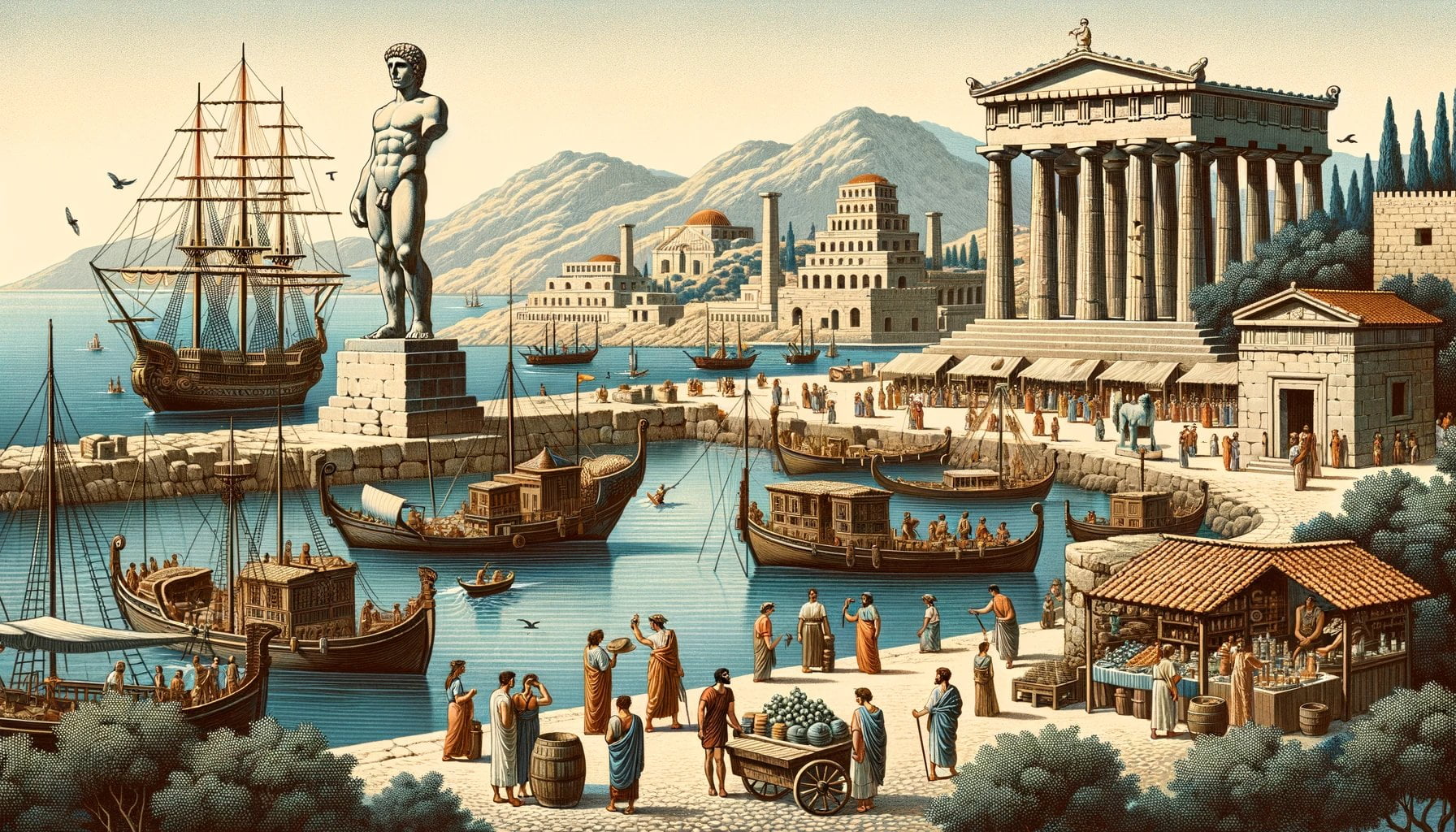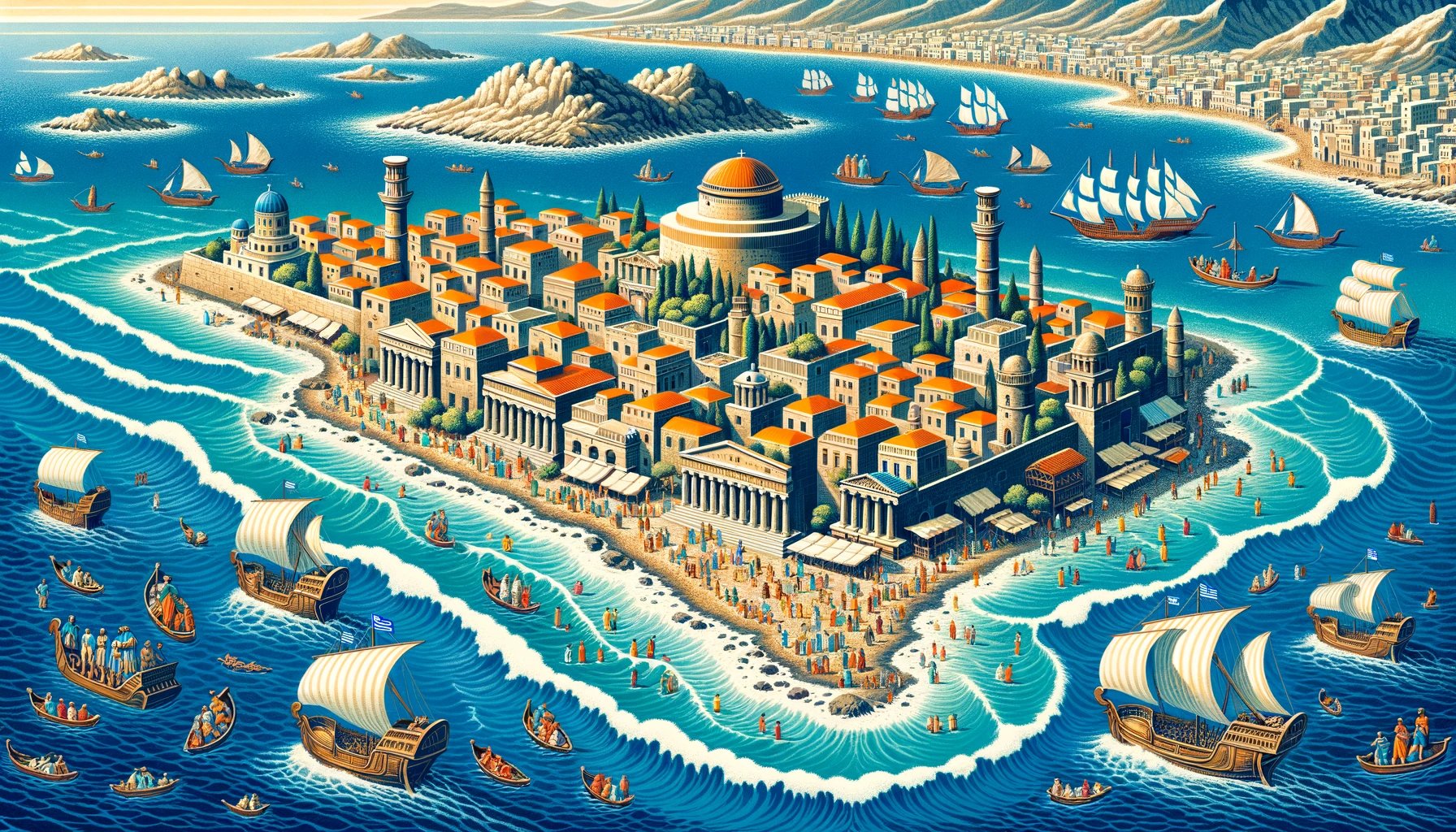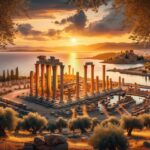Discover the fascinating history of Rhodes in ancient Greece, a city-state renowned for its maritime trade, awe-inspiring Colossus, and profound cultural significance. Delve into the intricate tapestry of this remarkable civilization, as we explore its pivotal role in international commerce, its architectural wonders that left the ancient world in awe, and its enduring contributions to art and philosophy. Join us on a journey through time and uncover the captivating story of Rhodes in ancient Greece.

Key Takeaways:
- Rhodes is a major city and island in Greece with a rich history dating back to the Neolithic period.
- In Greek mythology, Rhodes is associated with the nymph Rhodos and the sun god Helios.
- The island was inhabited by the Minoans in the 16th century BC.
- Rhodes has several archaeological sites, including the Acropolis of Rhodes from the 5th century BC.
- The medieval city of Rhodes is a UNESCO World Heritage site.
- Rhodes offers a diverse cuisine featuring fresh seafood, olive oil, and local produce.
- The island is known for its beautiful beaches and historical attractions, attracting tourists from around the world.
Rhodes in Ancient Greece
When it comes to ancient civilizations, Rhodes holds a significant place in history. This captivating city-state, located in the South Aegean region of Greece, boasts a rich and intricate past that has left an indelible mark on the world. From maritime trade to architectural wonders like the Colossus, Rhodes has much to offer in terms of both cultural significance and historical relevance.
A Journey through Time
To truly understand the marvels of Rhodes in ancient Greece, we must delve into its fascinating history. Dating back to the Neolithic period, this island has witnessed the rise and fall of civilizations, each contributing to its unique heritage. According to Greek mythology, Rhodes itself is associated with the nymph Rhodos and the sun god Helios, lending an aura of mysticism to its identity.
Cultural Melting Pot
Rhodes, being a major trading hub, was exposed to diverse cultures and ideas, making it a melting pot of civilization. From the Minoans who inhabited the island in the 16th century BC to the subsequent influence of the Mycenaeans, Rhodes became a vibrant center of cultural exchange. As you explore the archaeological sites, immerse yourself in the whispers of ancient civilizations, allowing the past to come alive.
Architectural Marvels
One cannot discuss Rhodes without mentioning its architectural wonders. The Acropolis of Rhodes, dating back to the 5th century BC, stands as a testament to the city’s grandeur. It is a testament to the architectural prowess and innovative vision of ancient Greek civilization.
Maritime Trade
Rhodes’ strategic location made it a vital maritime trade hub, attracting merchants from far and wide. Its bustling harbor was teeming with ships carrying precious cargo, connecting various regions and facilitating the exchange of ideas and goods. The island’s prominence in maritime trade contributed to its prosperity, enriching its society and fostering cultural growth.
The Colossus of Rhodes
No discussion of Rhodes in ancient Greece would be complete without mentioning the legendary Colossus. This iconic statue, standing guard at the entrance of the harbor, symbolized the city’s power and grandeur. Towering above the landscape, the Colossus of Rhodes was a testament to the artistic and engineering prowess of its time, leaving all who beheld it in awe.
Delights for the Senses
Rhodes, with its captivating history, also tantalizes the taste buds. Its cuisine, flavored with fresh seafood, olive oil, and local produce, is a delightful exploration of Greek gastronomy. From succulent octopus dishes to savory Mediterranean-inspired delights, Rhodes offers a sensory journey through its unique flavors and aromas.
Alluring Beaches and Historical Attractions
Apart from its historical significance, Rhodes enthralls visitors with its breathtaking beaches and historical attractions. The island’s stunning coastline boasts crystal-clear waters and golden sands. Combined with ancient ruins and architectural gems, Rhodes is an enticing destination for those seeking both relaxation and cultural exploration.
In conclusion, Rhodes in ancient Greece stands as a testament to the ingenuity and cultural significance of its time. From its pivotal role in maritime trade to its architectural wonders and the allure of its cuisine, Rhodes offers a composite picture of a civilization that shaped the world we know today. Embrace the opportunity to immerse yourself in the intricate history of Rhodes and discover the depths of its cultural significance.
In ancient Greece, the region of Laconia was known for its rich history and culture. Discover more about Laconia and its significance in ancient Greece by clicking here.
When exploring the ancient wonders of Greece, don’t forget to delve into the fascinating history of the Black Sea region. Click here to uncover the secrets of ancient Greece’s connection to the Black Sea.
Curious about the remarkable achievements of ancient Greece? Click here to discover the innovations and accomplishments that shaped the course of history.
One of the pivotal moments in ancient Greek history was the Battle of Salamis. Click here to learn more about this epic naval clash and its implications for the ancient Greeks.
Explore the rulers and leaders who shaped ancient Greece by clicking here. Discover the political landscape and influential figures that left a lasting impact on this remarkable civilization.
Cultural Significance and Contributions of Rhodes
Rhodes, an enchanting island in Greece, holds a deep cultural significance and has made significant contributions to ancient Greek civilization. Let’s delve into the intriguing history and explore the vibrant tapestry of Rhodes in ancient Greece.
A Melting Pot of Civilization
Rhodes, with its rich and intricate past, dates back to the Neolithic period and intertwines with captivating Greek mythology^[1]^. Situated at the crossroads of trade routes, the island became a major trading hub, leading to a fusion of diverse cultures and a flourishing exchange of ideas and goods. The vibrant mingling of civilizations on Rhodes shaped its cultural identity and played a pivotal role in its historical narrative.
Maritime Power and Trade Hub
Rhodes flourished as a vital maritime trade hub, connecting various regions and facilitating the exchange of goods and knowledge^[2]^. Its geographical location granted it a privileged position in Mediterranean affairs and enabled the island to establish strong trade relationships with neighboring cities and beyond. Through maritime commerce, Rhodes amassed wealth and influence, solidifying its place in Greek history.
The Colossus of Rhodes: Symbol of Power and Splendor
One of the most iconic symbols of Rhodes’ cultural significance is the Colossus of Rhodes, a colossal statue that once stood proudly at the entrance to the island’s harbor. This magnificent structure, considered one of the Seven Wonders of the Ancient World, exemplified the city’s power, grandeur, and artistic prowess. Imagining the awe-inspiring sight of the Colossus leaves us captivated by the remarkable achievements of ancient Rhodes.
Contributions to Art and Philosophy
Rhodes, renowned for its cultural contributions, also left an indelible mark on the realms of art and philosophy. The island’s architectural wonders, including the Acropolis of Rhodes, showcased the skill and creativity of its inhabitants. These marvels of ancient Greek architecture not only captivated the eyes but also served as a testament to the ingenuity and cultural sophistication of Rhodes.
Moreover, Rhodes nurtured a vibrant intellectual scene, attracting esteemed philosophers and stimulating lively debates. The island became a center for philosophical inquiry and played a vital role in shaping ancient Greek philosophical thought. Scholars from Rhodes made significant contributions to various branches of philosophy, fostering a legacy that continues to inspire and enrich us today.
Key Takeaways:
- Rhodes, an island in Greece, holds significant cultural importance and made notable contributions to ancient Greek civilization.
- The island’s geographical position as a trade hub facilitated cultural exchange and the flourishing of diverse civilizations.
- The Colossus of Rhodes, an impressive statue, symbolized the city’s power and artistic achievements.
- Rhodes’ architectural wonders, such as the Acropolis, showcased its cultural sophistication.
- The island’s intellectual scene and contributions to philosophy further enhanced its cultural significance.
Sources:
– Rhodes – World History Encyclopedia
– Rhodes | Ancient City & Island Paradise | Britannica
Architectural wonders of Rhodes, including the Colossus
The magnificent city-state of Rhodes in ancient Greece was renowned for its architectural wonders, each reflecting the grandeur and artistic prowess of its inhabitants. Among these awe-inspiring structures, the Colossus of Rhodes stood as a symbol of power, resilience, and artistic mastery. Let’s explore this architectural marvel and its significance in the history of Rhodes.
The Colossus of Rhodes: The Giant Sun God Statue
The Colossus of Rhodes, built in 280 BC, was an enormous statue standing in the ancient Greek city of Rhodes. This iconic statue was dedicated to the sun god Helios and was considered one of the Seven Wonders of the World. Created by the skilled sculptor Chares of Lindos, this architectural masterpiece took an impressive 12 years to complete.
Siege and Construction
The construction of the Colossus was a testament to the city’s victory and resilience. Rhodes, being a crucial trading port in the ancient Mediterranean, attracted the attention of Demetrius I of Macedon, who besieged the city for a year with a large army and navy. Despite the siege, Rhodes successfully defended itself, and the construction of the Colossus became a symbol of their triumph.
The Statue’s Physical Features
Made primarily of bronze and iron, the Colossus of Rhodes depicted the majestic deity Helios holding a torch and a spear. Its height stood at an estimated 33 meters (108 feet), towering over the landscape. The statue was hollow, allowing visitors to climb a spiral staircase within its structure and reach an observation platform at the top, which offered breathtaking views of Rhodes.
Destruction and Legacy
Unfortunately, the Colossus of Rhodes stood for a relatively short period before succumbing to an earthquake in 226 BC. The statue collapsed at its weakest point, the knee area. The remains of the statue remained on the ground for centuries, captivating the imagination of all who beheld them. Ultimately, Arab invaders disassembled and sold the remnants as scrap metal in the 7th century AD.
Key Takeaways:
- The Colossus of Rhodes, an architectural wonder of ancient Greece, was a colossal statue dedicated to the sun god Helios.
- Built in 280 BC, this statue stood at around 33 meters (108 feet) tall and was made of bronze and iron.
- It took 12 years to construct and served as a symbol of victory and resilience for the city of Rhodes.
- Unfortunately, the Colossus fell victim to an earthquake in 226 BC and was eventually disassembled and sold as scrap metal.
- Although the statue no longer exists, its legend and impact on ancient Greek history continue to fascinate people worldwide.
References:
– Britannica – Colossus of Rhodes
– Wikipedia – Colossus of Rhodes
Rhodes in Maritime Trade and Its Role in the Region
Ancient Greece was a hub of cultural and intellectual exchange, and one city-state that played a pivotal role in this exchange was Rhodes. Situated in the eastern Aegean Sea, Rhodes possessed a strategic location that made it a key player in maritime trade and commerce. In this article, we will explore the importance of Rhodes in maritime trade and its significant role in the region during ancient times.
Rhodes: A Center of Trade and Prosperity
Rhodes owed much of its prosperity and growth to its strategic position at the intersection of major trade routes. As a result, the city-state established itself as a powerful maritime hub, boasting a strong navy that further contributed to its influence in the region.
Trade played a crucial role in the ancient Greek world, and Rhodes was at the forefront of this economic activity. Its maritime traders were renowned for their expertise and played a vital role in facilitating the exchange of goods, ideas, and culture across different regions. Rhodes became a melting pot of civilizations, where diverse cultures converged, fostering a vibrant atmosphere of cultural exchange and intellectual discourse.
The Colossus of Rhodes: Symbol of Power and Grandeur
One of the most iconic landmarks associated with Rhodes is the Colossus of Rhodes. This colossal statue, standing approximately 33 meters (108 feet) tall, was dedicated to the sun god Helios. Built in 280 BC, the statue served as a symbol of the city’s power, grandeur, and artistic prowess. Visitors to Rhodes marveled at the sheer size and beauty of this architectural wonder.
Maritime Trade and Cultural Exchange
Rhodes’ position as a maritime trade hub allowed for the seamless flow of goods and knowledge. The city-state’s remarkable trade networks connected various regions, fostering cultural exchanges and facilitating the spread of ideas. The impact of Rhodes on maritime trade extended far beyond its shores, influencing the development of commerce and contributing to the cultural enrichment of the entire region.
Key Takeaways:
- Rhodes, in ancient Greece, was strategically located at the crossroads of major trade routes, which played a significant role in its prosperity and importance in the region.
- The city-state of Rhodes established itself as a powerful maritime hub with a strong navy, further enhancing its influence.
- Rhodes was renowned for its maritime traders, who played a vital role in facilitating the exchange of goods and ideas across different regions.
- The Colossus of Rhodes, an iconic statue dedicated to the sun god Helios, symbolized the city’s power and grandeur.
- Rhodes’ maritime trade networks contributed to cultural exchanges and the spread of knowledge throughout the region.
Sources:
- Britannica – Rhodes: Ancient City & Island Paradise
- World History Encyclopedia – Trade in Ancient Greece

FAQ
Q1: What is the historical significance of Rhodes in ancient Greece?
A1: Rhodes had a significant role in ancient Greece as a powerful maritime city-state and a center of trade and commerce. It was known for its strong navy and its location on major trade routes, contributing to its growth and prosperity.
Q2: What is the Colossus of Rhodes?
A2: The Colossus of Rhodes was a massive statue of the sun god Helios that stood in the ancient Greek city of Rhodes. It was considered one of the Seven Wonders of the Ancient World and was an architectural marvel.
Q3: How was the Colossus of Rhodes destroyed?
A3: The Colossus of Rhodes stood for approximately 50 years before it was toppled by an earthquake in 226 BC. The statue collapsed at its weakest point, the knee area. The remains of the statue were eventually disassembled and sold as scrap metal by Arab invaders in the 7th century AD.
Q4: What was the cultural significance of Rhodes in ancient Greece?
A4: Rhodes was known as a cultural center in ancient Greece. It was famous for the Colossus of Rhodes statue, one of the Seven Wonders of the Ancient World. The island’s mythical origin is associated with the sun god Helios and his wife Rhodos, adding to its cultural significance.
Q5: Where can I find more information about Rhodes in ancient Greece?
A5: To learn more about Rhodes and its significance in ancient Greece, you can visit reputable sources such as Britannica’s article on “Rhodes – Ancient City & Island Paradise” (https://www.britannica.com/place/Rhodes-Greece) and the World History Encyclopedia’s article on “Trade in Ancient Greece” (https://www.worldhistory.org/article/115). These sources provide detailed information about the history, trade, and cultural significance of Rhodes.












